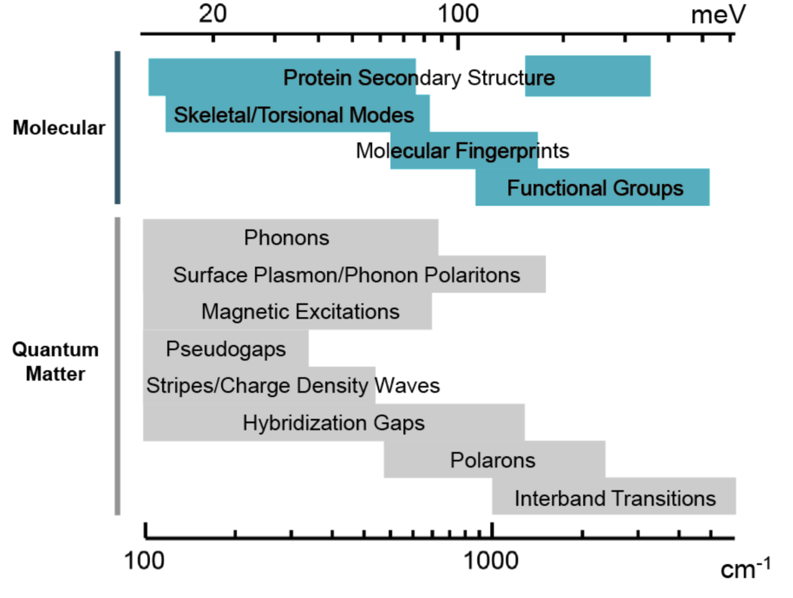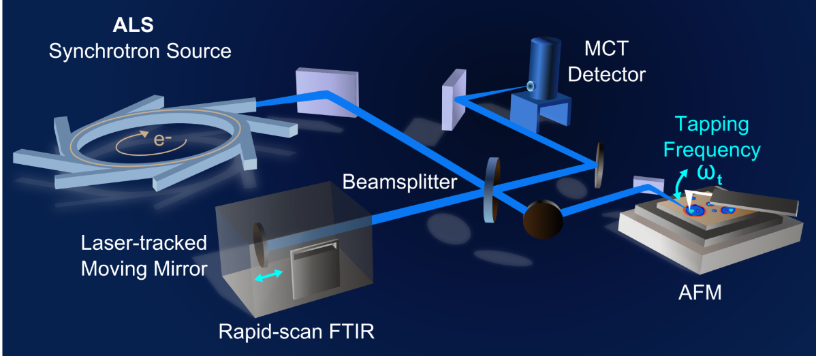— Overview
The ALS Infrared program operates three beamlines with multiple endstations. Some endstations are available for use with internal sources (i.e. when synchrotron user beam is not available). Please see below and contact the Beamline staff for more information.
What can we measure with IR?

ACS Photonics 5 (7), 2773-2779 (2018)
Far-Field Micro-Spectroscopy
Diffraction-limited spatial resolution in the mid-IR (2-20 μm)
IR micro-spectroscopy measurements can be collected in either reflection or transmission; however, the analysis of transmission measurements is generally more straightforward. Consideration of the sample surface preparation and thickness is required for good measurements. Optimal thickness, for instance, depends on how strongly the material absorbs in the spectral region of interest. Appropriate preparation is therefore highly material-dependent.

Endstation 1.4.3 Micro-Spectroscopy
Synchrotron FTIR, Standard MCT detection, Reflection and Transmission Modes, Large area mapping. The system is presently capable of remote operation.
Endstation 1.4.4 Micro-Spectroscopy
Synchrotron FTIR, Standard MCT detection, Reflection and Transmission Modes, Large area mapping, Florescence microscopy.
Endstation 5.4.2 Continuum Micro-Spectroscopy
Synchrotron FTIR, Standard MCT detection, Reflection and Transmission Modes, Large area mapping, Florescence microscopy.
Additional Far-Field Tools
These apparatus operate with internal sources — no synchrotron beam is available or the instruments are not connected to a Beamline.
Endstation 2.4.2 Agilent FPA Micro-Spectroscopy
Focal Plane Array (FPA) MCT detection for simultaneous spectral map collection over areas up to 700 μm x 700 μm.
Tomography is under development at this endstation – Please contact the beamline staff before submitting a User Proposal.
Endstation 5.4.3 Bruker IFS 125 Ultra-High Resolution FTIR
Spectral resolution < 0.001 cm-1. NOTE: Advanced discussion with beamline staff is required prior to submitting a User Proposal.
Raman Microscope
The microscope is equipped with 532 nm and 780 nm lasers and is available to Users taking data at the other IR endstations.
Near-Field Nano-Spectroscopy and Imaging
~20 nm (AFM tip-limited) spatial resolution in the mid to far IR (3 – 30 μm)
IR nano-spectroscopy measurements are considered to be surface techniques with a penetration depth typically less than 100 nm and require samples that are compatible with an atomic force microscope (AFM), which ideally means surface roughness less than +/- 100 nm. The improved spatial resolution over far-field techniques comes at a cost of reduced signal to noise.

With the SINS technique, light is focused onto the apex of a metallicized probe and localized to the dimensions of the probe radius. A light-matter interaction arises from the mutual polarization of the sample and near-field probe, and is resonantly enhanced when the incident light frequency corresponds to a vibrational mode in the sample. By scanning the probe across the sample surface, the optical response is mapped with spatial resolution defined by the probe.
The near-field signal is a complex quantity related to the dielectric response of the probe and sample, which displays as a change in amplitude of the scattered light field and a phase delay. The near-field phase and the imaginary component of the near-field electric field are both approximate measures of the absorption of the material. Note: Slight blue shifts of absorption resonances on the order of 10 cm-1 frequently occur for strong oscillators. Similar shifts are observed in different far-field IR measurement modalities.
Samples must be compatible with an atomic force microscope (AFM) for measurements to be successful: surface roughness, dimensions, and adhesion are all factors which should be considered when preparing to take measurements. If possible, verify sample compatibility by collecting AFM topography measurements before your beamtime.
Endstation 2.4.1 Nano-FTIR (NeaSpec)
Two modules are available to users:
-
- Nano-FTIR utilizes the synchrotron IR for ultrabroadband spectroscopy and imaging. Requires synchrotron user beam.
- Nano-Imaging uses tunable lasers for single frequency imaging or stitching together the near-field response at single frequency. Does not require user beam.
Endstation 5.4.1 Synchrotron Infrared Nano-Spectroscopy (SINS)
SINS requires synchrotron IR for ultrabroadband spectroscopy and white light imaging.